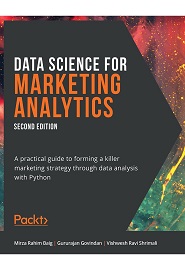
English | 2021 | ISBN: 978-1800560475 | 636 Pages | PDF, EPUB, MOBI | 189 MB
Turbocharge your marketing plans by making the leap from simple descriptive statistics in Excel to sophisticated predictive analytics with the Python programming language
Key Features
- Use data analytics and machine learning in a sales and marketing context
- Gain insights from data to make better business decisions
- Build your experience and confidence with realistic hands-on practice
Unleash the power of data to reach your marketing goals with this practical guide to data science for business.
This book will help you get started on your journey to becoming a master of marketing analytics with Python. You’ll work with relevant datasets and build your practical skills by tackling engaging exercises and activities that simulate real-world market analysis projects.
You’ll learn to think like a data scientist, build your problem-solving skills, and discover how to look at data in new ways to deliver business insights and make intelligent data-driven decisions.
As well as learning how to clean, explore, and visualize data, you’ll implement machine learning algorithms and build models to make predictions. As you work through the book, you’ll use Python tools to analyze sales, visualize advertising data, predict revenue, address customer churn, and implement customer segmentation to understand behavior.
By the end of this book, you’ll have the knowledge, skills, and confidence to implement data science and machine learning techniques to better understand your marketing data and improve your decision-making.
What you will learn
- Load, clean, and explore sales and marketing data using pandas
- Form and test hypotheses using real data sets and analytics tools
- Visualize patterns in customer behavior using Matplotlib
- Use advanced machine learning models like random forest and SVM
- Use various unsupervised learning algorithms for customer segmentation
- Use supervised learning techniques for sales prediction
- Evaluate and compare different models to get the best outcomes
- Optimize models with hyperparameter tuning and SMOTE
Resolve the captcha to access the links!